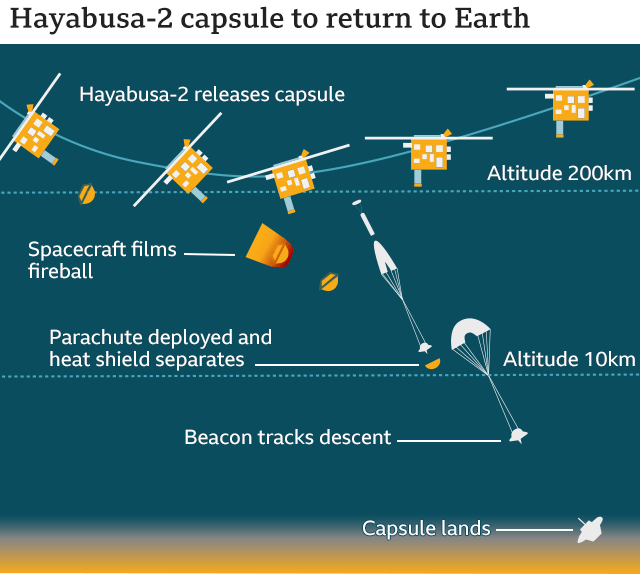Dust Samples from Hayabusa 2 | 07 Dec 2020
Why in News
Recently, Japan Aerospace Exploration Agency (JAXA) has received a capsule from the unmanned Hayabusa 2, carrying the first extensive samples of dust from the asteroid Ryugu.
Key Points
- Hayabusa 2 was launched from Japan’s Tanegashima space centre in 2014 and took four years to reach the asteroid Ryugu.
- The mission builds on the original Hayabusa mission that was launched in 2003 and successfully linked up with asteroid Itokawa in 2005.
- It returned samples to Earth in 2010 marking the first time when sample materials from an asteroid were brought back to Earth.
- Hayabusa is the Japanese term used for the peregrine falcon, which is the fastest bird during its hunting dive (200 mile per hour).
- The mission builds on the original Hayabusa mission that was launched in 2003 and successfully linked up with asteroid Itokawa in 2005.
- The space probe orbited above the asteroid for a few months to map its surface before landing. Then it used small explosives to blast a crater, collected the resulting debris and headed back to Earth in November 2019.
- The craft’s mission seeks to answer some fundamental questions about the origins of the Solar systemand where molecules like water came from.
- Significance:
- Asteroids and comets are primitive bodies that can be considered to be the building blocks of the early Solar system and they hold a record of the birth and initial evolution.
- Larger planets like Earth went through a more complex evolution over which the pristine materials were melted and altered significantly. Due to this change, the materials found on large planets do not hold information into their early stages of formation.
- Asteroids and comets retain a record of when, where and in what conditions they were formed. Exploration of these primitive bodies is essential in gaining insight into the formation of the Solar system.
- Gases trapped in the rock samples could reveal more about the chemical mixture from the planets formed.
- Significantly, among all the reasons that will eventually cause the extinction of life on Earth, an asteroid hit is widely acknowledged as one of the likeliest.
Asteroids
- Asteroids are also known as minor planets and are made up of metals and rocks.
- They orbit the Sun and have shorter and elliptical orbits.
- Most asteroids are irregularly shaped, though a few are nearly spherical.
- Many asteroids are known to have a small companion moon (some have two moons).
- There are also binary (double) asteroids, in which two rocky bodies of roughly equal size orbit each other, as well as triple asteroid systems.
- Classification of Asteroids:
- Main Asteroid Belt: The majority of known asteroids orbit within the asteroid belt which is a torus-shaped region in the Solar system, located roughly between the orbits of the planets Mars and Jupiter.
- Trojans: These asteroids share an orbit with a larger planet, but do not collide with it because they gather around two special places in the orbit (called the L4 and L5 Lagrangian points). There, the gravitational pull from the sun and the planet are balanced.
- Lagrange Points: These are positions in space where the gravitational forces of a two body system like the Sun and the Earth produce enhanced regions of attraction and repulsion. These can be used by spacecraft to reduce fuel consumption needed to remain in position.
- Near-Earth Asteroids: These objects have orbits that pass close by that of Earth. Asteroids that actually cross Earth's orbital path are known as Earth-crossers.

